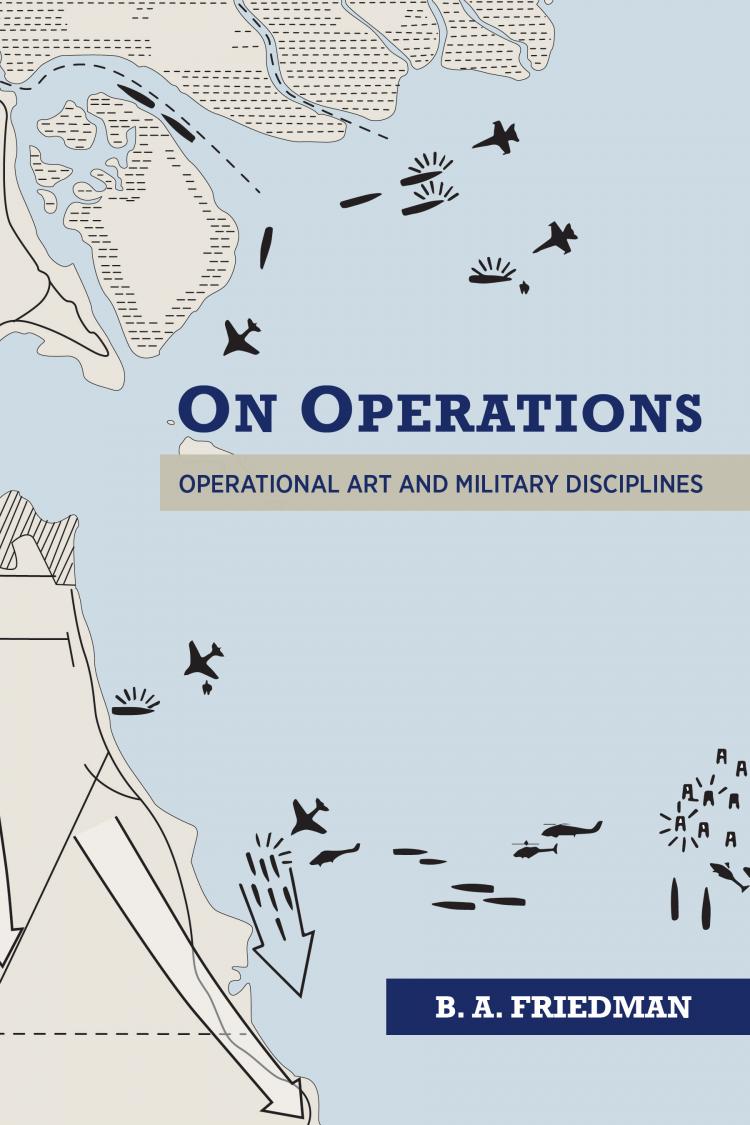Reviewed by1
Luke P. Bellocchi
Associate Professor of Practice, JFSC
 In On Operations: Operational Art and Military Disciplines, Brett Friedman provides a comprehensive study of military operations from a historical and theoretical basis. Friedman is a United States Marine officer, a graduate of the Naval War College, and On Operations is his second book. In the book, he reviews debates about how operations should be defined and used, along with historical examples of application, leading to a distillation and evaluation of contemporary thinking about how operational art can best serve modern military campaigns. The crux of Friedman’s book is his proposed theory of operational art, which he describes as having more to do with “how military staffs should be trained, organized, and equipped.”
In On Operations: Operational Art and Military Disciplines, Brett Friedman provides a comprehensive study of military operations from a historical and theoretical basis. Friedman is a United States Marine officer, a graduate of the Naval War College, and On Operations is his second book. In the book, he reviews debates about how operations should be defined and used, along with historical examples of application, leading to a distillation and evaluation of contemporary thinking about how operational art can best serve modern military campaigns. The crux of Friedman’s book is his proposed theory of operational art, which he describes as having more to do with “how military staffs should be trained, organized, and equipped.”
Friedman defines operational art as “the planning, preparation, conduct, and sustainment of tactics aimed at accomplishing strategic effect,” requiring knowledge in the specific disciplines of administration, information, operations, fire support, logistics, and command and control. The disciplines roughly correspond to the U.S. joint staff functions outlined in U.S. joint doctrine (Joint Publication 1-0, Doctrine for the Armed Forces of the United States). After developing his theory, Friedman provides a few short chapters describing why the disciplines are critical to understanding operations. Friedman’s focus is highly theoretical, which may prove to divide potential audiences. To a student new to the study of the operational dimension of warfare, Friedman’s theory provides a good learning tool since it works both historically and conceptually. The more advanced learner may question whether Friedman’s semantic changes lead to benefits in practice.
In the introduction, Friedman provides his description of operational art as “what military staffs do to manage the complexity of modern warfare as a parallel supporting function to strategy and tactics without there being an interposing operational level of war.” In reviewing past debates on how staff officers should view operations, and providing his view, Friedman offers an objective and extensive examination of how operational art relates to the study of warfare, in both actuality and from an ideal point of view. However, by his own admission, the weakness is that it is entirely based on Western thinking on the subject and is very much focused on the land war aspects of operations.
Friedman’s historical analysis of operational art starts with German, Russian, and American military doctrine from the Napoleonic era with an emphasis on civil-military relationships. In the German case, the military divorced itself from civilian control leading to a dangerous “state within a state,” contributing to mistakes such as unrestricted submarine warfare in World War I (WWI) that won military objectives but lost civilian moral support. Conversely, the Russian case demonstrates what can happen when there is too much civilian interference in military affairs. Finally, he describes the American case to highlight the implications of policymakers who do not take enough responsibility for creating realistic political goals and a military that refuses to fill the void. Friedman’s solution: The military should not be partisan but cannot be apolitical.
Friedman attempts to use his theory and historical context to evaluate the modern staff system in the U.S. Friedman believes “what is needed is a marriage of the best part of the Scharnhorst Model—the career pipeline—with a ‘base model’ staff designed to be collaborative, along with the empowerment of commanders to modify their staff organization to meet each situation and mission.” In one recommendation, Friedman suggests that military organizations should modify training and education to provide a curriculum focused on staff actions from a staff perspective rather than from a commander’s perspective and operational theory. The recommendation will likely spark initial interest but ultimately leave readers unfulfilled. Indeed, some military education programs focus on developing the skills staff officers need to meet the requirements of a commander. One could certainly argue that good staffers must anticipate the needs of those they serve. Still, training could also focus on the needs of the staff to produce operational art apart from the perspective of a commander.
Friedman reviews many historical examples of and debates about operational art and, thus, it would be a good text to teach operations from a historical and theoretical perspective. Using the book in an educational setting would facilitate class discussion on what has happened and what is possible for developing operational art. Proportionally, the historical analysis comprises a large part of the book, which, for many readers, is likely to induce a feeling of delayed gratification. Comparatively, the evaluation of contemporary practices is short, which leaves many areas unexamined. Friedman’s book, however, as one can probably tell from the allusions to Clausewitzian theory in the title, is heavily philosophical. Additionally, his suggestions for change are perhaps too detached and underdeveloped for practical application. Ironically, practical application is the underpinning of operational art.
Book Information:
On Operations: Operational Art and Military Disciplines
by Brett Friedman
Naval Institute Press, 2021. 256 pp.
 Download the PDF version: click here
Download the PDF version: click here
1 The views expressed are those of the author(s) and do not reflect the official policy or position of Joint Forces Staff College, National Defense University, the Department of Defense, or the U.S. Government.